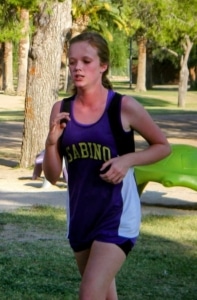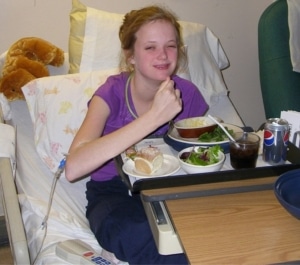As we mark World Diabetes Day on Nov. 14, C-Path’s Hailey Davenport reflects on life with T1D and how personal experience inspires her work to transform the future of diabetes research.

I’m Hailey Davenport, a Critical Path Institute (C-Path) employee since 2021, and currently a Senior Project Manager for the Type 1 Diabetes Consortium. I studied Biomedical Engineering and have spent over a decade working across clinical, academic, and industry perspectives of medical research. At C-Path, I’ve supported therapeutic efforts in sickle cell disease and rare neurodegenerative diseases, reinforcing the crucial need to bring solutions to those with conditions that have little to no treatment options. Now is the first time in my career that I am involved with the research of my own disease, type 1 diabetes (T1D), allowing me the opportunity to share the perspective of the patient. Despite life-changing advancements in technology since my diagnosis in 2008, current treatment for T1D merely treats the symptoms, not the underlying disease, and the psychological and physical burden persists. We can and need to do better for future generations. Because T1D is a complex, invisible, and misunderstood disease, sharing the patient perspective is crucial in advancing the field and developing innovative therapies. My lived experience of T1D drives me, and the ability to share it provides an even more meaningful layer to the work I do. In recognition of World Diabetes Day, I hope my story will offer perspective and hope.
C-Path’s recent workshop, 21st-century trials in new-onset T1D, provided me a platform to share my lived experience as the patient: being diagnosed at age 14 and how having had any additional time to live without T1D would have been huge in improving my quality of life. The workshop investigated the use of C-peptide and its potential to accelerate the development of therapies that could slow or stop the body’s autoimmune response in newly diagnosed T1D, thus delaying the onset of the disease. I was honored to present my story and the remaining challenges I face despite improvements in treatment.
I lived 14 years without T1D and for that, I am so grateful. I’ve been a dancer (ballet, tap, hip hop, jazz, and contemporary) since a young age, and a few months before diagnosis, I was on a cross-country team, somehow running long distances in the summer heat of Tucson, Arizona. I had no significant medical history. Among my biggest concerns were getting my braces off before starting high school and fitting in like a typical teenager. The diagnosis came on December 30, 2008, during winter break of my freshman year. I became very ill, feeling exhausted, rapidly losing weight, experiencing extreme thirst, frequent urination, nausea, and throwing up. Heading into my pediatrician’s office thinking it might be the flu, it was a massive shock for my doctor to identify my symptoms immediately and diagnose me with T1D within 10 minutes. I was so sick because of diabetic ketoacidosis (DKA), a major, life-threatening complication of untreated T1D that occurs when dangerous levels of ketones build up in the body. I was immediately hospitalized, where I’d stay several days, and put on subcutaneous insulin therapy. Doctors informed my family that if I hadn’t been hospitalized when I was, I could have entered a coma or died. At 14, I was faced with my own mortality, and there was no way to understand or grapple with the journey ahead, the years I’d live amidst continuous chaos. I had no family history of T1D and, like many folks, had no idea what it was or entailed.

Back then, there weren’t any treatment “options” for a newly diagnosed type 1 diabetic. The only available option was to inject myself with insulin for the rest of my life or die. Doctors said it was still possible for me to live a long life; I could still dance, run, and achieve any dreams that didn’t involve flying planes or scuba diving. But to do so, I would have to learn to think like my pancreas, at all hours of the day. Given no choice in the matter, I found myself bearing the eternal responsibility of acting as my now broken pancreas.
Taking on the responsibility of an organ is a complex and draining endeavor, involving continuous carbohydrate and insulin dosing calculations, insulin shots, and pricking my fingers to test my blood sugar throughout the day (and night). When treating T1D with injected insulin, it’s not simply a matter of taking the drug and going on with your day, easy does it. Instead, it feels like constantly trying to hit a moving target. The amount of insulin my body needs changes from minute to minute, depending on fluctuations in my blood sugar levels, which are impacted by many factors beyond food (e.g., exercise, stress, hormones, caffeine).

Forever at the mercy of my fluctuating blood sugar, the (quite literal) highs and lows are taxing and never-ending. Too much insulin causes low blood sugar (hypoglycemia), which can lead to coma or death if not immediately treated with fast-acting sugar (cue the juice box!). Low blood sugar stops you in your tracks, interrupts whatever you’re doing, and makes you feel irritable, dizzy, shaky, have brain fog, and have a rapid heart rate. Too little insulin causes high blood sugar (hyperglycemia), which, in addition to immediate symptoms of irritability, blurred vision, nausea, brain fog, headaches, and dizziness, dramatically increases the risk of developing future complications such as kidney disease, blindness, neuropathy, and an overall shorter life expectancy.
Advancements in medical devices, such as insulin pumps and continuous glucose monitoring, have greatly improved my quality of life. Nowadays, I am kept alive by an insulin pump. My pump is an anchor of sorts; 2 feet of tubing attached to what looks like a pager from the ’90s. Powered by an AA battery that will indeed die at the most inopportune time, it continuously pumps insulin into my body, and I can’t be safely disconnected from it for more than 15 minutes. Among the more “minor” annoyances of the disease are the challenges posed by wearing a medical device 24/7. Pumps are water-resistant, not waterproof, so swimming always presents a challenge. The tubing frequently gets caught on doorknobs, ripping the infusion site out of my skin. I experience infusion site infections and allergies to most medical tapes. My body is coated in scabs, scars, and puncture marks — a human pin cushion with a million tiny holes.
T1D is often misunderstood and can mistakenly be attributed to an unhealthy diet or lifestyle, alluding to the idea that because I have diabetes, it is somehow my fault. Many folks don’t know that type 1 is an autoimmune disease. For almost 17 years, I’ve entertained countless comments from strangers who notice my insulin pump. Comments such as: “You don’t look diabetic,” “Should you be eating that?,” “You must have been an overweight child,” “Why are you wearing a pager?,” “Cinnamon can cure that,” to name a few. Nowadays, I am used to it. As a young teenager, it was isolating to feel I had a disease that was not only misunderstood but seemed to have a level of stigma surrounding it.
Feeling burned out is inevitable. T1D never takes a break — not even during sleep — creating a perpetual cycle of calamity. I have always struggled with a constant and nagging fear of low blood sugar — worrying that one will happen during an exam, an important meeting, or during the night, from which I may not wake up. This fear of lows resulted in me running high blood sugar levels over the years, increasing the fear of future complications. This fear has only grown since I was diagnosed with early signs of Diabetic Retinopathy at age 28, a condition that will only get worse with time. Sleeping through the night rarely happens, and there is seldom any sense of peace. In addition, internalized stigma around the disease contributes to feelings of shame and failure relating to poor glycemic control.
T1D isn’t something you conquer or beat once you start insulin therapy. It’s not something that I once experienced a long time ago in the hospital at 14. It’s something that happens to me again and again, every moment of every day. To an onlooker, T1D can appear invisible. Hidden under an apparently calm and even surface is a never-ending state of chaos and disruption. Every moment of every day is accompanied by a steady hum of countless decisions being made in the background. The invisibility of the disease is a testament to the strength and fortitude people with T1D are forced to develop to continue to survive, but we shouldn’t have to be so strong.
Sometimes, envisioning a future with T1D can feel impossible. What will the future hold for me? How can I expect a future when it seems so dark and cloudy? A looming threat of horrible complications. In a reality where imagining the future can feel dim, I find hope through my work at C-Path. Through my professional experience, I’ve seen firsthand the bottlenecks and challenges faced when bringing new therapies to patients. C-Path works to bring people together to solve unmet needs that no single group can address on its own and to connect the dots between patients, science, and solutions.
Recent advancements in disease-modifying therapies for T1D that can slow or even halt the autoimmune process before it begins are monumental for patients. It’s my mission to do all I can to ensure that future generations experience T1D better than I did — if at all. Together, I know we will make this happen.


